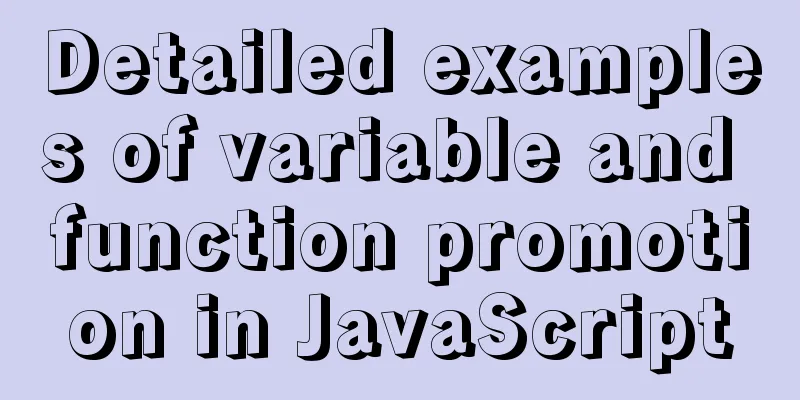Detailed examples of variable and function promotion in JavaScript

js execution
Variable Hoisting
🌰 1: console.log(num) var num num = 6 After precompilation var num console.log(num) // undefined num = 6 🌰 2: num = 6 console.log(num) var num After precompilation var num num = 6 console.log(num) // 6 🌰 3:
function bar() {
if (!foo) {
var foo = 5
}
console.log(foo) // 5
}
bar()
After precompilation
function bar() {
var foo // declaration hoisted inside if statement if (!foo) {
foo = 5
}
console.log(foo)
}
bar()
Function promotion
🌰 1: Function declarations can be hoisted
console.log(square(5)) // 25
function square(n) {
return n * n
}
After precompilation
function square(n) {
return n * n
}
console.log(square(5))
🌰 2: Function expressions cannot be hoisted
console.log(square) // undefined
console.log(square(5)) // square is not a function
var square = function(n) {
return n * n
}
After precompilation
var square
console.log(square)
console.log(square(5))
square = function() {
return n * n
}
🌰 3:
function bar() {
foo() // 2
var foo = function() {
console.log(1)
}
foo() // 1
function foo() {
console.log(2)
}
foo() // 1
}
bar()
After precompilation:
function bar() {
var foo
foo = function foo() {
console.log(2)
}
foo() // 2
foo = function() {
console.log(1)
}
foo() // 1
foo() // 1
}
Function hoisting precedes variable hoisting🌰 1:
console.log(foo) // will print out the function function foo() {
console.log('foo')
}
var foo = 1
🌰 2:
var foo = 'hello' // hello
;(function(foo) {
console.log(foo)
var foo = foo || 'world'
console.log(foo) //hello
})(foo)
console.log(foo) // hello
After precompilation
var foo = 'hello'
;(function(foo) {
var foo
foo = 'hello' // The value of foo passed in as parameter console.log(foo) // hello
foo = foo || 'world' // foo has the value hello, so it is not assigned the value world
console.log(foo) // hello
})(foo)
console.log(foo) // hello, prints var foo = 'hello' in the global scope
The order of JS variable promotion and function promotion Recently, I encountered a question in a written test that examined the order of variable hoisting and function hoisting. Before, I only knew that variables defined by var would be hoisted and function declarations would also be hoisted, but I did not study their order and detailed process in depth. After consulting the information and verifying it myself, I came to my own understanding of their order. Without further ado, let's get straight to the point. First of all, I would like to give my conclusion: function promotion has a higher priority than variable promotion, and will not be overwritten by a variable with the same name when it is declared, but will be overwritten after the variable with the same name is assigned a value. You can see the following code:
console.log(a) // ƒ a(){} Before assigning a value to variable a, function a will be printed.
var a=1;
function a(){}
console.log(a) // 1 After variable a is assigned, the value printed will be the value of variable aFirst, both variable and function declarations are hoisted, but the function hoisting priority is higher than the variable. After both are hoisted, the variable is only defined without assignment, so the output is function a. The detailed process is as follows:
function a(){} // Function declaration promotion a->fa (){}
var a; // Variable promotion console.log(a) // At this time, variable a is just declared without assignment, so it will not overwrite function a --> Output function afa (){}
a=1; //Variable assignment console.log(a) // At this time, variable a is assigned --> Output the value of variable a 1
Summary: Since both function declarations and variables are hoisted, if a function has the same name as a variable, then the function will be printed before the variable is assigned a value, and the value of the variable will be printed after the variable is assigned a value. Now let's look at another piece of code:
a(); // 2
var a = function(){ // Treat it as a function assigned to variable a
console.log(1)
}
a(); // 1
function a(){
console.log(2)
}
a(); // 1
In fact, I just want to tell you that only function declarations will be hoisted, not function expressions. Therefore, the code after the function expression will output 1, because the variable a is assigned to overwrite the hoisted function a. The detailed process is as follows:
function a(){ // Function promotion console.log(2)
}
var a; // variable promotion a(); // 2
a = function(){ // After the variable a is assigned, it will overwrite the function a above
console.log(1)
}
a(); // 1
a(); // 1
Let’s look at another piece of code:
a();
function a(){
console.log(1)
}
function a(){
console.log(2)
}
What is printed is 2. The reason is simple: the one declared first will be overwritten by the one declared later. SummarizeThis is the end of this article about variable hoisting and function hoisting in JavaScript. For more relevant js variable hoisting and function hoisting content, please search 123WORDPRESS.COM’s previous articles or continue to browse the following related articles. I hope everyone will support 123WORDPRESS.COM in the future! You may also be interested in:
|
<<: A brief understanding of MySQL SELECT execution order
>>: Detailed explanation of the principle of Docker image layering
Recommend
How to install docker on centos
Here we only introduce the relatively simple inst...
How to Install Oracle Java 14 on Ubuntu Linux
Recently, Oracle announced the public availabilit...
Create a new user in Linux and grant permissions to the specified directory
1 Create a user and specify the user's root p...
Realizing the effect of carousel based on jQuery
This article shares the specific code of jQuery t...
HTML design pattern daily study notes
HTML Design Pattern Study Notes This week I mainl...
React hooks pros and cons
Table of contents Preface advantage: shortcoming:...
Nginx compiled nginx - add new module
1. View existing modules /usr/local/nginx/sbin/ng...
How to create an Nginx server with Docker
Operating environment: MAC Docker version: Docker...
Solution for installing opencv 3.2.0 in Ubuntu 18.04
Download opencv.zip Install the dependencies ahea...
Based on the special characters in the URL escape encoding
Table of contents Special characters in URLs URL ...
Summary of Linux date command knowledge points
Usage: date [options]... [+format] or: date [-u|-...
JavaScript gets the scroll bar position and slides the page to the anchor point
Preface This article records a problem I encounte...
CSS Sticky Footer Several Implementations
What is "Sticky Footer" The so-called &...
JavaScript Basics Objects
Table of contents 1. Object 1.1 What is an object...
Installing Windows Server 2008 operating system on a virtual machine
This article introduces the installation of Windo...









